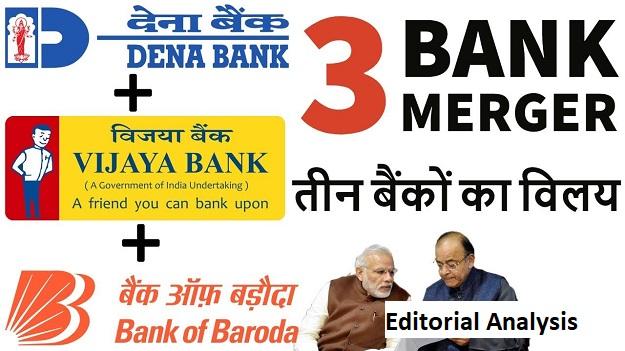The merger of two strong banks (BoB and Vijaya) with a weak bank (Dena Bank) seems like a bailout package for Dena Bank, keeping aside strong bank’s minority shareholder’s interest.
The Alternate Mechanism (headed by Arun Jaitley ), comprising Jaitley, defence minister Nirmala Sitharaman and railways and coal minister Piyush Goyal, was set up as an approval framework for proposals to merge state-run banks.
2 STRONG + 1 WEAK BANK
Vijaya Bank is the only profit-making state-run bank and the only one that paid a dividend to the government in 2017-18.
Dena Bank, on the other hand, is facing restriction on lending and expanding business under PCA and is heavily dependent on the government for capital support.
The government announced the amalgamation of three banks — Bank of Baroda, Vijaya Bank and Dena Bank — aimed at creating the country’s third-largest bank with a business of Rs 14.82 lakh crore and over 9,600 branches across the country.
About banks
Vijaya Bank: Mangalore based has its presence in south India.
Dena Bank: Base in Gujarat and Maharashtra.
Bank of Baroda: Strong in western and northern India.
NOTES :
PCA: Bank cannot give the loan to the private organisation, only to the government organisation.
Of the three banks, Dena Bank is currently under the Prompt Corrective Action (PCA) framework and has been restrained from further lending.
It has a gross NPA ratio of 22 per cent – among the highest across the industry.
Vijaya Bank, on the contrary, is among the better performing public sector banks with a gross NPA ratio of 6.9 per cent.
Bank of Baroda, the largest of the three, has a bad loan ratio of 12.4 per cent.
Banks under PCA are prohibited from fresh lending, paying dividends, and distributing profits. They are also required to keep an eye on provisioning on bad loans.
RAGHURAM RAJAN WON’T HAVE LIKED THE IDEA.
The merger of two (or more) unhealthy banks in the financial system will create an unhealthy entity that would lead to the creation of a bigger problem in the economy.
Secondly, even in the case of the merger of an unhealthy bank with a large healthy bank, the merger would bring problems to the acquiring bank.
Thirdly, in the event of a merger of a weak bank with a strong bank, the acquirer will have to deal with the cultural problems that arise out of the merger, besides dealing with the primary challenge — the bad loan pile in the weak bank, thereby creating difficulties for the strong bank.”
He wanted that strong banks should merge together.
THE RESULT OF THE MERGER
With a combined business of Rs 14.82 lakh crore, 9,560 branches, and an employee strength of 85,675 would be India’s third largest globally competitive bank.
The merger of Bank of Baroda, Vijaya Bank and Dena Bank will create a lender which will be the third largest in India.
Banks will stop competing with each other.
BACKGROUND ON MERGER OF BANKS
Consolidation of state-run banks was first mooted by the first Narasimham committee in 1991.
Three categories of bank
1.Three large banks with the international presence
2.Around 8-10 national banks
3.Several other regional banks
What The New Bank Will Look Like
The combination of Bank of Baroda-Dena Bank-Vijaya Bank will create a lender with a nationwide reach. While Bank of Baroda already has a widespread network, Dena Bank and Vijaya Bank are more regionally focused.
The merged bank will have an advances base of Rs 6.4 lakh crore.
It will have a deposit base of Rs 8.41 lakh crore.
In absolute terms, the gross non-performing assets(NPAs) will be at roughly Rs 80,000 crore.
That suggests that the gross NPA ratio will work out to be about 13 per cent.
MERGER IN PUBLIC SECTOR BANKS
The current proposal to merge all the state PSB’s comes in the backdrop of increasing NPA’s and consequent deteriorated asset quality and lower earnings.






















 WhatsApp
WhatsApp